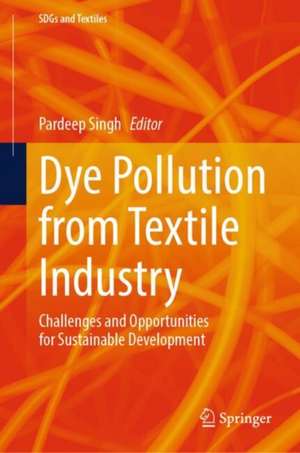Dye Pollution from Textile Industry: Challenges and Opportunities for Sustainable Development: SDGs and Textiles
Editat de Pardeep Singhen Limba Engleză Hardback – 24 sep 2024
Preț: 1013.50 lei
Preț vechi: 1235.98 lei
-18% Nou
Puncte Express: 1520
Preț estimativ în valută:
193.96€ • 201.75$ • 160.12£
193.96€ • 201.75$ • 160.12£
Carte tipărită la comandă
Livrare economică 14-28 aprilie
Preluare comenzi: 021 569.72.76
Specificații
ISBN-13: 9789819753406
ISBN-10: 9819753406
Pagini: 453
Ilustrații: X, 340 p.
Dimensiuni: 155 x 235 mm
Greutate: 0.84 kg
Ediția:2024
Editura: Springer Nature Singapore
Colecția Springer
Seria SDGs and Textiles
Locul publicării:Singapore, Singapore
ISBN-10: 9819753406
Pagini: 453
Ilustrații: X, 340 p.
Dimensiuni: 155 x 235 mm
Greutate: 0.84 kg
Ediția:2024
Editura: Springer Nature Singapore
Colecția Springer
Seria SDGs and Textiles
Locul publicării:Singapore, Singapore
Cuprins
Part 1: Dye Pollution and Environmental Pollution.- Chapter 1: Understanding Dye Pollution and its Impact on the Environment.- Chapter 2: Textile Dyes and its impact on the natural environment.- Chapter 3: Dyes and Unveiling the Environmental story of dye pollution.- Part 2: Technological Solution for remediation of dye from the Environment.- Chapter 4: Technological Solutions for Dye Removal from the Natural Environment.- Chapter 5: Advances in dye-containing wastewater treatment technologies.- Chapter 6: Nanomaterials across the Periodic Table as the Promising Agents for the Remediation of Dye-contaminated Water: A Review.- Chapter 7: Carbon nanotubes application in the bioremediation of heavy metals and dyes from wastewater.- Chapter 8: Removal of dyestuffs from dyeing industry effluents by microbe-mediated oxide nanoparticles (NPs) via adsorption for sustainable development. etc.
Notă biografică
Dr. Pardeep Singh is presently an assistant professor at the Department of Environmental Science, PGDAV College, University of Delhi New Delhi, India. He obtained his master’s degree from the Department of Environmental Science Banaras Hindu University, Varanasi, India. He obtained his doctorate from the Indian Institute of Technology Banaras Hindu University, Varanasi. He has published more than 65 papers in international journals. He has also edited more than 45 books with various global publishers.
Textul de pe ultima copertă
This book provides a comprehensive overview of the challenges associated with dye pollution and highlights opportunities for sustainable development in the textile industry. It discusses the environmental and health impacts of textile dyeing, the regulations and standards related to dye pollution, and the available technologies and strategies for reducing dye pollution. One of the significant challenges associated with dye pollution is the contamination of water resources. The book further discusses the available technologies and strategies for reducing water consumption and improving water treatment in the textile industry. The book also highlights the importance of adopting sustainable production processes and waste management strategies to minimize toxic waste products and eco-friendly textile production. This book is a valuable resource for researchers, industry professionals, policymakers, and anyone interested in the environmental impact of textile production.
Caracteristici
Covers innovative textile production and waste management Discusses regulatory frameworks and standards in textile industries Provides a comprehensive overview of the challenges associated with dye pollution





